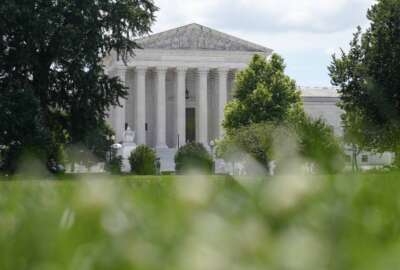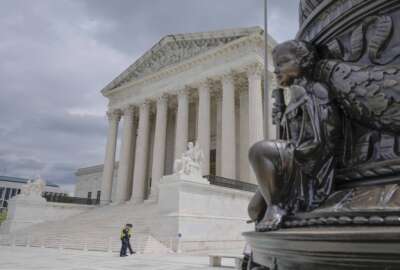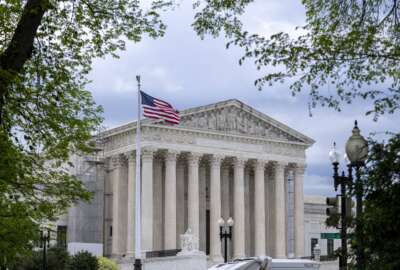Agencies ‘knew this was coming.’ What does — and doesn’t — change after Supreme Court’s Chevron ruling
Agencies are likely to see an uptick in legal challenges to their regulations — especially those that impact the environment and health care.
The Supreme Court, in a trio of decisions, is redefining the extent to which federal agencies can interpret laws passed by Congress, and pass regulations that put them into effect.
In a 6-3 ruling on June 28, the court overturned a 40-year precedent that gave agencies more latitude in crafting regulations, allowing them to fill in the gaps when the legislation text is ambiguous.
In Loper Bright Enterprises v. Raimondo, the Supreme Court eliminated Chevron deference — a legal precedent from a 1984 case that required judges to defer to an agency’s interpretation of relevant laws when its regulations are challenged in court.
Two other Supreme Court decisions further compound the effect of eliminating Chevron deference.
Former agency officials and legal experts say the full impact of overturning Chevron isn’t immediately clear, but agreed that agencies could soon see an uptick in legal challenges — especially to older regulations previously sheltered from further legal scrutiny.
Regulatory agencies, however, are continuing with their own goals. The Biden administration released the latest version of its rulemaking agenda last week, outlining hundreds of rules agencies intend to advance.
Here’s what the experts say will change for agencies post-Chevron — and what won’t.
What else did the Supreme Court decide?
The Supreme Court overturned Chevron deference in Loper Bright Enterprises v. Raimondo. But in an earlier ruling, the Supreme Court extended the timeframe businesses have to challenge federal regulations in court.
In Corner Post v. Board of Governors of the Federal Reserve System, the court determined that agency regulations are no longer exempt from legal challenges six years after going into effect.
Rather, the court’s conservative majority determined that the statute of limitations is actually six years after a plaintiff suffers injury from the regulation in question.
Caroline Wolverton, former senior trial counsel for the Justice Department Civil Division’s Federal Programs Branch — now senior counsel at the law firm Akin Gump Strauss Hauer & Feld — said the court’s ruling in Corner Post “opens up regulations that have been on the books for many years to new challenges.”
“It opens the possibility that people who disfavor particular regulations, for whatever reason, can form a business and they know that the nature of the business is going to conflict with the regulation — will adversely affect the business complying with the regulation. Then all of a sudden, they’re going to be able to challenge that rule. So you might see more manufactured challenges, in that sense,” Wolverton said.
In a third case, Securities and Exchange Commission v. Jarkesy, the court ruled that the SEC’s standard practice of issuing fines through administrative proceedings violated the Seventh Amendment right to a jury trial. The ruling is likely to rein in the authority of administrative law judges across the federal government.
What agencies are most impacted?
Wolverton said agencies are likely to see an uptick in legal challenges to their regulations — especially those that impact the environment and health care.
The Environmental Protection Agency and the Centers for Medicare and Medicaid Services, she added, have a lot of older regulations on the books that are once again vulnerable to legal challenges, following the Supreme Court’s Corner Post ruling.
“Those could be areas where you see upticks in litigation,” she said.
Wolverton said she expects agencies will see the greatest uptick in older regulations
“Agencies have been trying to move away from relying on ambiguities in anticipation of deference from courts. But that wasn’t the case before the court’s inclination to overrule Chevron became clear,” she said.
Harley Geiger, counsel at the law firm Venable, wrote in a blog post with his colleagues that the court’s ruling are likely to have a “seismic effect” on digital security policy, because many federal regulations involve interpretations of older statutory authorities that predate modern cybersecurity practices and threats.
Geiger wrote that digital security regulations will be more prone to court challenges where agency interpretations have unclear statutory backing, and that future rulemakings and enforcement actions will need to hew more closely to statutory authority to avoid judicial modifications.
“The Supreme Court’s reversal of Chevron likely sets up an influx of cases challenging agency decisions. While the full impact will unfold over time, it is apparent that industries accustomed to navigating legal frameworks shaped by agency interpretations now confront a landscape where judicial scrutiny will alter the consistency and scope of regulatory guidance and enforcement actions,” Geiger told Federal News Network
Former OIRA Administrator Susan Dudley, a distinguished professor of practice at the George Washington University’s Trachtenberg School of Public Policy & Public Administration, said agency rulemaking — at least up until now —kept up with the pace with technology changes more than Congress and its ability to pass legislation.
In the 1980s, for example, the Food and Drug Administration, Agriculture Department, National Institutes of Health, and the National Science Foundation began to contemplate their role in regulating the emerging field of biotechnology and gene modification.
“’How do we do it?’ Do we need a brand-new statute, because this is so novel?’ The agencies got together and realized that actually, they didn’t, because their existing statutes, the pesticide laws, the food and drug laws, all focused on the product — to make sure the product was safe for public use,” Dudley said. “By focusing their regulation on the product, they were able to do it. That has survived and in fact led to a lot of exciting new products that have improved our lives.”
“Maybe if they focus on the outcomes, they’d like to see — products that are safe for human consumption — that will be sufficient to give some agencies the wiggle room they need to apply their expertise, without having to create new legal authority from something that wasn’t there,” she added.
Will agencies see more legal challenges?
Dudley said she expects an uptick in legal challenges of agency rules — at least in the short term.
“There’ll be a lot more discussion about whether that’s the most reasonable rather than it is simply a reasonable interpretation,” she said.
However, courts and regulatory agencies anticipated an end to Chevron deference before this Supreme Court’s ruling this summer.
Dudley said lower courts were already citing Chevron less in their decisions before the Supreme Court’s landmark decision.
“It’s probably not as significant as either their proponents or the opponents make it out to be,” Dudley said, regarding the magnitude of the Supreme Court’s rulings. “Proponents of changing Chevron really hope that it will make Congress step up and do their job — legislate more, and pass the buck less. And opponents use phrases like, ‘It’ll kneecap the administrative state, prevent agencies from protecting your air and water quality and food safety.’ I don’t think either of those are likely to be true. And it’ll take a while to sort out, because it’s certainly a change in jurisprudence. But I don’t think the impact on the state will be as dramatic.”
Wolverton said agencies have anticipated a Supreme Court challenge of Chevron deference, and that more recent regulations adhere to the text of authorizing statutes much more closely.
“Agencies knew this was coming, the government knew this was coming. They have been moving away from relying on ambiguities in statutes, finding ambiguities and claiming that they are interpreting what the statute should mean in those areas. So it’s not a huge change, in that respect,” Wolverton said.
The Associated Press reports that the Supreme Court hasn’t invoked Chevron in any of its rulings since 2016, although lower courts have continued to do so.
“You don’t see government attorneys arguing so much, at least in the Courts of Appeals and the Supreme Court,” Wolverton said. “At least in those higher courts, you don’t see as many arguments that courts should be deferring to agencies in their interpretations of the statute.”
“I have seen agencies not relying on their interpretations of a statute as being ambiguous, as at least a primary rationale for whatever rulemaking they are engaged in. Maybe they’ll have it as a backup, to the extent that there is an ambiguity, we think that our rule makes the most sense for these policy reasons. But the agencies are trying to insulate themselves from a Chevron overruling, have not been relying on any ambiguity in statutes,” she added.
How is the Biden administration responding?
The Biden administration is moving ahead undeterred with its own regulatory wish list.
The White House’s Office of Information and Regulatory Affairs (OIRA) last Friday released its 2024 spring regulatory agenda, highlighting the major regulations agencies plan to advance later this year.
OIRA Associate Administrator Sam Berger, in a blog post last Friday underscored how agencies are “hearing directly from those most affected by an issue or problem” when crafting regulations.
“Improving public engagement is an important and ongoing effort, and agencies and OIRA will continue to identify opportunities for supporting meaningful public engagement in the regulatory process,” Berger wrote. “Hearing from the people, businesses, and other stakeholders most impacted by a particular issue or problem can help agencies better understand how to effectively address that issue, leading to better, more targeted rulemaking that is more responsive, effective, durable, and equitable.”
Agency expertise still counts
In legal challenges to agency rulemaking, Dudley said courts “will still defer to the agencies’ expertise” — including technical, scientific and economic analyses.
“That will not change,” she said. “When agencies justify their regulation, it starts with, ‘Here’s our statutory authority.’ It has to start there. But the bulk of that regulatory impact analysis, the preamble of their regulation, is all these other factors — the alternatives they considered and why this is the best alternative, given their expertise.”
Chief Justice John Roberts, in his majority opinion in Loper, specified that agency experience and expertise in regulated areas is relevant to statutory interpretation.
“Roberts said that they still should, or may, look to the agency’s expertise [and] experience and use that in the court’s independent interpretation of this statute,” Dudley said.
“Agency expertise is still relevant,” she added. “You might see courts looking to that and relying on that more in science-heavy or tech-heavy areas — FDA regulations come to mind. I think courts might hesitate to second-guess the way the FDA views the Food and Drug Act, when it comes to medications, things like that.”
A chilling effect on new regulations?
When it comes to proposing new regulations, Dudley said agencies may be a “little less ambitious,” and that they may “think twice before finding some novel authority in an older statute.”
“What will change is there will be a greater focus on that first step — what does the law say? What are we authorized to do?” she said. “We may see agencies engaging the Department of Justice and the White House counsel, the cross-cutting legal parts of the government, on those questions before they go down a path. There may be earlier engagement on that.”
Wolverton said agencies may take an extra level of precaution when drafting rules.
“Agencies do generally take great care in issuing regulations as a general matter. But maybe now recognize the importance of taking that care is even more important, or it’s heightened now,” Wolverton said. “But in terms of not taking on particular areas of regulation, I would have a hard time believing that an agency that feels that there is a need for a particular regulation just wouldn’t issue it at all. I think that they’ll be more careful in how they justify it.,” Wolverton said
“Agencies give input to Congress, and agencies might be pressing for more express delegations of authority to issue regulations in particular areas,” she said. “That’s a way that Congress can explicitly recognize that there is going to be a gap, and that it wants the agency to fill that. Agencies might be pressing for language that does explicitly authorize them to fill gaps.”
Copyright © 2025 Federal News Network. All rights reserved. This website is not intended for users located within the European Economic Area.
Jory Heckman is a reporter at Federal News Network covering U.S. Postal Service, IRS, big data and technology issues.
Follow @jheckmanWFED






